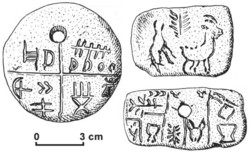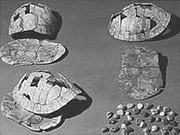History of WritingFrom Wikipedia, the free encyclopedia.
The history of writing encompass the various writing systems that evolved in the Early Bronze Age (late 4th millennium BC) out of neolithic proto-writing.
[edit] Proto-writing
The early writing systems of the late 4th millennium BCE were not a sudden invention. They were rather based on ancient traditions of symbol systems that cannot be classified as writing proper, but have many characteristics strikingly reminiscent of writing, so that they may be described as proto-writing. They may have been systems of ideographic and/or early mnemonic symbols that allowed to convey certain information, but they are probably devoid of linguistic information. These systems emerge from the early Neolithic, as early as the 7th millennium BC. Notably the Vinca script shows an evolution of simple symbols beginning in the 7th millennium, gradually increasing in complexity throughout the 6th millennium and culminating in the Tä rtä ria tablets of the 5th millennium with their rows of symbols carefully aligned, evoking the impression of a "text". The hieroglyphic scripts of the Ancient Near East (Egyptian, Sumerian proto-Cuneiform and Cretan) seamlessly emerge from such symbol systems, so that it is difficult to say, already because very little is known about the symbols' meanings, at what point precisely writing emerges from proto-writing. In 2003, 7th millennium BC radiocarbon dated symbols Jiahu Script carved into tortoise shells were discovered in China. The shells were found buried with human remains in 24 Neolithic graves unearthed at Jiahu, Henan province, northern China. According to some archaeologists, the writing on the shells had similarities to the 2nd millennium BC Oracle bone script.[1]; others[citation needed], however, have dismissed this claim 'as nonsense', claiming that simple geometric designs such as those found on the Jiahu Shells, cannot be linked to early writing. The 4th millennium BC Indus script may similarly constitute proto-writing, possibly already influenced by the emergence of writing in Mesopotamia. [edit] Invention of writingThe oldest-known forms of writing were primarily logographic in nature, based on pictographic and ideographic elements. Most writing systems can be broadly divided into three categories: logographic, syllabic and alphabetic (or segmental); however, all three may be found in any given writing system in varying proportions, often making it difficult to categorise a system uniquely. The invention of the first writing systems is roughly contemporary with the beginning of the Bronze Age in the late Neolithic of the late 4th millennium BC. The first writing system is generally believed to have been invented in Sumer, by the late 3rd millennium developing into the archaic cuneiform of the Ur III stage. Contemporaneously, the Proto-Elamite script developed into Linear Elamite. The development of Egyptian hieroglyphs is also parallel to that of the Mesopotamian scripts, and not necessarily independent. The Egyptian proto-hieroglyphic symbol system develops into archaic hieroglyphs by 3200 BC (Narmer Palette) and more widespread literacy by the mid 3rd millennium (Pyramid Texts). The Indus script develops over the course of the 3rd millennium, either as a form of proto-writing, or already an archaic mode of writing, but its evolution was cut short by the decline of the Indus Valley Civilization around 1900 BC. The Chinese script may have originated independently of the Middle Eastern scripts, around the 16th century BC (early Shang Dynasty), out of a late neolithic Chinese system of proto-writing dating back to c. 6000 BC. The pre-Columbian writing systems of the Americas (including Olmec and Mayan) also had independent origins. Almost all known writing systems of the world today are ultimately descended from writing as developed either in Egypt - see Genealogy of scripts derived from Proto-Sinaitic - or in China. There have been a number of notable exceptions, such as the Mayan hieroglyphs of Mesoamerica (developing from ca. the 3rd century BC), and possibly Rongorongo of the Easter Island. [edit] Bronze Age writing
Writing emerged in a variety of different cultures in the Bronze age. [edit] Cuneiform scriptThe original Sumerian writing system was derived from a system of clay tokens used to represent commodities. By the end of the 4th millennium BC, this had evolved into a method of keeping accounts, using a round-shaped stylus impressed into soft clay at different angles for recording numbers. This was gradually augmented with pictographic writing using a sharp stylus to indicate what was being counted. Round-stylus and sharp-stylus writing was gradually replaced about 2700-2500 BC by writing using a wedge-shaped stylus (hence the term cuneiform), at first only for logograms, but developed to include phonetic elements by the 29th century BC. About 2600 BC cuneiform began to represent syllables of the Sumerian language. Finally, cuneiform writing became a general purpose writing system for logograms, syllables, and numbers. From the 26th century BC, this script was adapted to the Akkadian language, and from there to others such as Hurrian, and Hittite. Scripts similar in appearance to this writing system include those for Ugaritic and Old Persian. [edit] Egyptian hieroglyphsWriting was very important in maintaining the Egyptian empire, and literacy was concentrated among an educated elite of scribes. Only people from certain backgrounds were allowed to train to become scribes, in the service of temple, pharaonic, and military authorities. The hieroglyph system was always difficult to learn, but in later centuries was purposely made even more so, as this preserved the scribes' position. [edit] Chinese writingIn China historians have found out a lot about the early Chinese dynasties from the written documents left behind. From the Shang Dynasty most of this writing has survived on bones or bronze implements. Markings on turtle shells have been carbon-dated to around 1500 BC. Historians have found that the type of media used had an effect on what the writing was documenting and how it was used. There have recently been discoveries of tortoise-shell carvings dating back to c. 6000 BC, like Jiahu Script,Banpo Script,but whether or not the carvings are of sufficient complexity to qualify as writing is under debate[2]. If it is deemed to be a written language, writing in China will predate Mesopotamian cuneiform, long acknowledged as the first appearance of writing, by some 2000 years. Undisputed evidence of writing in China dates from ca. 1600 BC.
[edit] Elamite scriptsThe undeciphered Proto-Elamite script emerges from as early as 3200 BC and evolves into Linear Elamite by the later 3rd millennium, which is then replaced by Elamite Cuneiform adopted from Akkadian. [edit] Anatolian hieroglyphsAnatolian hieroglyphs are an indigenous hieroglyphic script native to western Anatolia first appears on Luwian royal seals, from ca. the 20th century BC, used to record the Hieroglyphic Luwian language. [edit] Cretan scriptsCretan hieroglyphs are found on artifacts of Minoan Crete (early to mid 2nd millennium BC, MM I to MM III, overlapping with Linear A from MM IIA at the earliest). They remain undeciphered. [edit] Early Semitic alphabetsThe first pure alphabets (properly, "abjads", mapping single symbols to single phonemes, but not necessarily each phoneme to a symbol) emerged around 1800 BC in Ancient Egypt, as a representation of language developed by Semitic workers in Egypt, but by then alphabetic principles had already been inculcated into Egyptian hieroglyphs for a millennium. These early abjads remained of marginal importance for several centuries, and it is only towards the end of the Bronze Age that the Proto-Sinaitic script splits into the Proto-Canaanite alphabet (ca. 1400 BC) Byblos syllabary and the South Arabian alphabet (ca. 1200 BC). The Proto-Canaanite was probably somehow influenced by the undeciphered Byblos syllabary and in turn inspired the Ugaritic alphabet (ca. 1300 BC). [edit] Indus scriptThe Middle Bronze Age Indus script has not yet been deciphered. It is unclear whether it should be considered an example of proto-writing (a system of symbols or similar), or if it is actual writing of the logographic-syllabic type of the other Bronze Age writing systems. [edit] Iron Age and the rise of alphabetic writingThe Phoenician alphabet is simply the Proto-Canaanite alphabet as it was continued into the Iron Age (conventionally taken from a cut-off date of 1050 BC). This alphabet gave rise to the Aramaic and Greek, as well as, likely via Greek transmission, to various Anatolian and Old Italic (including the Latin) alphabets in the 8th century BC. The Greek alphabet for the first time introduces vowel signs. The Brahmic family of India probably originated via Aramaic contacts from ca. the 5th century BC. The Greek and Latin alphabets in the early centuries AD gave rise to several European scripts such as the Runes and the Gothic and Cyrillic alphabets while the Aramaic alphabet evolved into the Hebrew, Syriac and Arabic abjads and the South Arabian alphabet gave rise to the Ge'ez abugida. Meanwhile, the Japanese script was derived from the Chinese from ca. the 4th century AD. [edit] Writing and historicityHistorians draw a distinction between prehistory and history, with history defined by the presence of autochthonous written sources. The emergence of writing in a given area is usually followed by several centuries of fragmentary inscriptions that cannot be included in the "historical" period, and only the presence of coherent texts (see early literature) marks "historicity". In the early literate societies, as much as 600 years passed from the first inscriptions to the first coherent textual sources (ca. 3200 to 2600 BC). In the case of Italy, about 500 years passed from the early Old Italic alphabet to Plautus (750 to 250 BC), and in the case of the Germanic peoples, the corresponding time span is again similar, from the first Elder Futhark inscriptions to early texts like the Abrogans (ca. 200 to 750 AD). [edit] See also
[edit] Further reading
[edit] External links
Sources |



